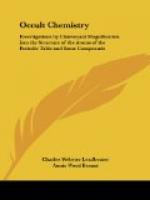To any power of sight which we can bring to bear upon it, this koilon appears to be homogeneous, though it is probably nothing of the kind, since homogeneity can belong to the mother-substance alone. It is out of all proportion denser than any other substance known to us, infinitely denser—if we may be pardoned the expression; so much denser that it seems to belong to another type, or order, of density. But now comes the startling part of the investigation: we might expect matter to be a densification of this koilon; it is nothing of the kind. Matter is not koilon, but the absence of koilon, and at first sight, matter and space appear to have changed places, and emptiness has become solidity, solidity has become emptiness.
To help us to understand this clearly let us examine the ultimate atom of the physical plane (see pp. 21-23). It is composed of ten rings or wires, which lie side by side, but never touch one another. If one of these wires be taken away from the atom, and be, as it were, untwisted from its peculiar spiral shape and laid out on a flat surface, it will be seen that it is a complete circle—a tightly twisted endless coil. This coil is itself a spiral containing 1680 turns; it can be unwound, and it will then make a much larger circle. This process of unwinding may be again performed, and a still bigger circle obtained, and this can be repeated till the seven sets of spirillae are all unwound, and we have a huge circle of the tiniest imaginable dots, like pearls threaded on an invisible string. These dots are so inconceivably small that many millions of them are needed to make one ultimate physical atom, and while the exact number is not readily ascertainable, several different lines of calculation agree in indicating it as closely approximate to the almost inconceivable total of fourteen thousand millions. Where figures are so huge, direct counting is obviously impossible, but fortunately the different parts of the atom are sufficiently alike to enable us to make an estimate in which the margin of error is not likely to be very great. The atom consists of ten wires, which divide themselves naturally into two groups—the three which are thicker and more prominent, and the seven thinner ones which correspond to the colors and planets. These latter appear to be identical in constitution though the forces flowing through them must differ, since each responds most readily to its own special set of vibrations. By actual counting it has been discovered that the numbers of coils or spirillae of the first order in each wire is 1680; and the proportion of the different orders of spirillae to one another is equal in all cases that have been examined, and correspond with the number of dots in the ultimate spirillae of the lowest order. The ordinary sevenfold rule works quite accurately with the thinner coils, but there is a very curious variation with regard to the set of three. As may be seen from the drawings, these are obviously




